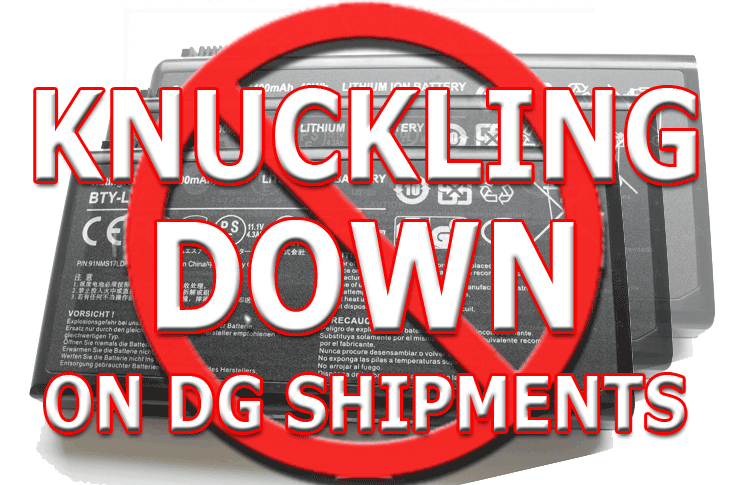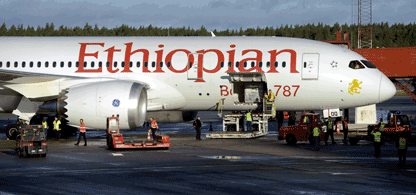Lithium Dangers To Air Cargo

 he
exhaustive report released late last month by The UAE General Civil
Aviation Authority (GCAA) of how a consignment of on fire, runaway lithium
ion batteries brought down a UPS B747 Freighter over Dubai in 2010 ,
has not gone unanswered by the big cargo carrier. he
exhaustive report released late last month by The UAE General Civil
Aviation Authority (GCAA) of how a consignment of on fire, runaway lithium
ion batteries brought down a UPS B747 Freighter over Dubai in 2010 ,
has not gone unanswered by the big cargo carrier.
FlyingTypers learned that UPS has ordered 1,821 fire resistant
containers capable of containing a fire with temperatures as high as
1,200F for more than 4 hours.
Deliveries reportedly start in September
2013 and will be complete by early 2014. The objective is to enable
the flight crew to land the aircraft in case of a fire.
Additionally UPS has purchased 575 fire
containment pallet covers.
"The fire resistant ULDs are part
of a broader safety overhaul of the cargo carrier’s fleet, based
on recommendations from the UPS Independent Pilots Association (IPA)
safety task force, organized after the accident,” a source told
FT.


Elsewhere The FedEx Master Executive
Council (MEC) joined Air Line Pilots Association (ALPA) in their commendation
of the GCAA’s report.
Commenting on the text of the massive
GCAA text, Rep, Master Executive Council (MEC) Chairman Captain Scott
Stratton declared:
“These pilots’ lives were
tragically cut short as they valiantly tried to bring their crippled
aircraft back to the ground.
“Through their actions, they were
able to prevent a much larger disaster from occurring.
“We owe it to them as well as to
all of those who fly this nation’s commerce every day, to ensure
that regulatory directives are harmonized across the globe and robust
enough to preclude future events such as this, ”Capt. Stratton
said.

No doubt lithium ion batteries, represents
a significant source of revenue to the airlines and that is an important
factor - particularly in this economy.
Basically, all Lithium batteries, no matter
which type or size, are subject to the regulatory requirements –
but to a greater or lesser degree.
These requirements stem from the UN Model
Regulations (in their current 17th Edition) and the associated “UN
Manual of tests and criteria” in its current 5th Edition). When
the UN Model Regulations change, all regulations change, with specified
grace periods for compliance – for the European road (ADR), a
grace period of six months, for the maritime sector (IMDG), a grace
period of one year and for the air mode, no grace period at all, which
is one of the unique challenges air shippers have to face.
The regulations require that any and all
batteries have successfully undergone testing in accordance with Part
III, subpart 38.3 of the UN Manual of Tests and Criteria. Untested cells
and batteries may only be shipped under special governmental permits,
and any battery assembled from already tested cells requires re-testing.
The main issue here is that battery and
equipment manufacturers usually refuse to give these test reports to
resellers and retailers.
Although there is a fair consensus on
the side of regulatory authorities worldwide to accept so-called “certificates
of conformity” in lieu of the full test report, the form and content
of these certificates has not been agreed upon and a considerable number
of these are actually unfit for the purpose of proving the required
compliance.
Furthermore, the UN Manual of Tests and
Criteria establishes just that – the test criteria, but there
is no verification required for whether or not the enterprise undertaking
such tests is actually qualified to conduct the tests.

It should be noted that on July 28, 2011
Asiana Flight 991, also a B 747 freighter, was lost under similar circumstances
off the Korean coast near Jeju, with the loss of two lives, the crew.

FlyingTypers has also learned
that an earlier incident resulting in the loss of UPS flight 1307 on
February 7, 2006 (fortunately without fatalities) pointed to the dangers
of lithium batteries. According to NTSB, “the probable cause ofthis
accident was an in-flight cargo fire that initiated from an unknown
source, which was
most likely located within cargo container 12, 13, or 14.
“Efforts were made to identify the
items shipped in these containers. As a result, about 25 of the items
were identified as electronic devices that potentially contained batteries,
including laptop computers, two uninterrupted power supplies, a digital
video recorder, and several credit card readers and bar code scanners.
“Although it could not be determined
whether lithium batteries played a role in the UPS cargo fire, public
hearing testimony and the continued occurrence of incidents involving
these batteries on board airplanes suggest the need for greater attention
to the risks posed by transporting these batteries on commercial aircraft.”

 The
much anticipated Boeing 787 Dreamliner took a huge hit as Lithium -Ion
related fire aboard a JAL Airways B787 on January 7th, 2013 led to the
suspension of an aircraft airworthiness certificate by the FAA, the
first time that has occurred in 34 years. The
much anticipated Boeing 787 Dreamliner took a huge hit as Lithium -Ion
related fire aboard a JAL Airways B787 on January 7th, 2013 led to the
suspension of an aircraft airworthiness certificate by the FAA, the
first time that has occurred in 34 years.
Eventually all the B787s were grounded,
dashing in an instant, the hopes and dreams of many of the world’s
greatest airlines.
Just as the B787s got back in the air
came the spectacle last month in London (LHR) of a suspect fire aboard
an Ethiopian Airlines 787 on July 12th, 2013.

Meantime almost unbelievably, IATA and
other stakeholders by means of LinkedIn forums downplayed that Ethiopian
July dust up and tried to contain speculation about the source of the
fire being Lithium battery-related by basically highlighting that the
location of the fire aboard the Ethiopian aircraft parked without passengers
and cargo on board was “far away from the location of the batteries”;
but alas Boeing’s stocks had already taken a sharp plunge following
initial WSJ and BBC reports.
Turned out that the preliminary accident
report published by the UK CAA identified the cause of the fire, a Lithium
battery installed in the aircraft’s Emergency Location Transmitter
(ELT).
In the meantime, Boeing has asked all
the operators of around 1,200 Boeing aircraft to inspect the Honeywell
ELT devices installed aboard these aircraft.
According to a Reuters report, a Boeing
spokesman said: ”Boeing is asking specific operators of 717, Next-Generation
737, 747-400, 767 and 777s to inspect aircraft with the Honeywell fixed
emergency locator transmitters.”
In the meantime, Airbus and Bombardier
are also reviewing the Honeywell ELTs installed on their aircraft.

FlyingTypers believes that there
are no parties more vested and interested in safety than the airlines
and this shouldn't be overlooked, minimized and lost in the back and
forth.
One prediction that scares the hell out
of us and should also at least shake your tree:
The “Freighter Airplane Cargo Fire
Risk, Benefit and Cost Model” study jointly undertaken by U.S.
FAA, Transport Canada, and UK CAA predicts that, if no mitigation action
is taken, in the period 2012 until 2021 there will be approximately
6 accidents, ranging from 2 to 12, at 95 percent confidence interval.
The accident costs are estimated to average
approximately USD$50 million per annum between 2012 and 2026.
While it seems easy to slam the airplane
builders for their planes not being able to withstand 90 tons of lithium
batteries going beserk, we all know the answer is somewhere in the middle.
And that answer certainly starts with
better understanding and guidelines and rules for DG shipments.
Our view is that it is past time for concerned
folks in air cargo transportation to bring some pressure to bear on
leading air cargo organizations to widen their agenda a bit and bring
some leveraged pressure to betterment of safeguards regarding DG shipments.
IATA, ICAO et -al are there to disseminate regulations, but the actual
technical work comes from organizations such as ISO, SAE and others.
AFA, FIATA and GACAG, although not in the regulatory business, usually
piggyback on IATA regulations.
It is in our industry’s interest
to be knowledgeable about the regulations and new technologies (See
FT
article December 10, 2012) available to prevent these incidents
and to raise a voice for harmonized safety standards.
Everyone in the supply chain has a stake
in safety and should use their bully pulpit to speak up and carry the
banner for safety at this time.

Here is an idea, if you are an air cargo
club in Boston or Delhi or Frankfurt or anywhere else, one way your
group might help is to raise a petition and send it to one or several
of the aforementioned organizations.
It may seem like a small thing but the way we figure, little things
can mean a lot in the big picture.
Geoffrey/Jens
|




